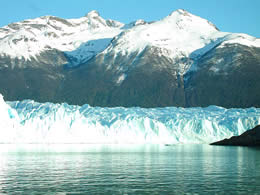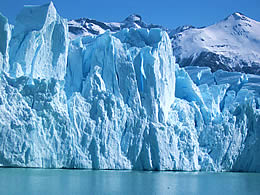Destinations
ARGENTINA
 Boasting
a rich culture and assorted landscapes, Argentina is the second
largest country (after Brazil) in South America, and the eighth
largest in the world. Here you will find some of the world's
tallest mountains, expansive deserts, and impressive waterfalls,
with the diversity of the land ranging from wild, remote areas
in southern Patagonia to the bustling metropolis of Buenos Aires
in the north. This is one Latin American country where Europeans
and North Americans can feel at ease and travel relatively inconspicuously.
From sophisticated Buenos Aires where the tango was born, to
the remote pristine Patagonia Region, Argentina offers something
for every type of visitor. This is where one may dine on what
is absolutely the world's best beef, experience the Argentine "Gaucho" (cowboy)
along the rolling, fertile Pampas, rich in agriculture, sheep
and cattle-grazing. Heading south you will find the vast wilderness
of the Patagonia, home to shimmering lakes, Glaciers and pristine
eco-systems.
Boasting
a rich culture and assorted landscapes, Argentina is the second
largest country (after Brazil) in South America, and the eighth
largest in the world. Here you will find some of the world's
tallest mountains, expansive deserts, and impressive waterfalls,
with the diversity of the land ranging from wild, remote areas
in southern Patagonia to the bustling metropolis of Buenos Aires
in the north. This is one Latin American country where Europeans
and North Americans can feel at ease and travel relatively inconspicuously.
From sophisticated Buenos Aires where the tango was born, to
the remote pristine Patagonia Region, Argentina offers something
for every type of visitor. This is where one may dine on what
is absolutely the world's best beef, experience the Argentine "Gaucho" (cowboy)
along the rolling, fertile Pampas, rich in agriculture, sheep
and cattle-grazing. Heading south you will find the vast wilderness
of the Patagonia, home to shimmering lakes, Glaciers and pristine
eco-systems.
 Located in South America, and thus, in the southern
hemisphere, Argentina has an area of almost 3.8 million square
kilometers (2.8 on the continent) – approximately 54% are plains
(grasslands and savannahs), 23% plateaus, and the other 23%,
mountains - and the remainder in the Antarctic. It is 3,800 Km
long and is located between latitude 22º and 55º. Its border
with Uruguay, Brazil, Paraguay, Bolivia and Chile has a perimeter
of 9,376 Km, while the territory bordered by the Atlantic Ocean
is 4,725 Km long.
Located in South America, and thus, in the southern
hemisphere, Argentina has an area of almost 3.8 million square
kilometers (2.8 on the continent) – approximately 54% are plains
(grasslands and savannahs), 23% plateaus, and the other 23%,
mountains - and the remainder in the Antarctic. It is 3,800 Km
long and is located between latitude 22º and 55º. Its border
with Uruguay, Brazil, Paraguay, Bolivia and Chile has a perimeter
of 9,376 Km, while the territory bordered by the Atlantic Ocean
is 4,725 Km long.
Although Argentina can be divided in 5 regions: Cuyo Region,
the Littoral region, the Central region, the Northern region
and the Patagonia region, its main characteristic is the enormous
contrast between the immense eastern plains and the impressive
Andes mountain range to the west. This is the frontier with Chile
and boasts the highest peak in the Western hemisphere: the 6,959
meter (22,34 feet) high Aconcagua.
From Jujuy to Tierra del Fuego, the Andes present marvelous contrasts: the Northwest plateaus, the lake region, the forests and glaciers in the Patagonia.
To the north, Chaco is a forested area linked to
rivers Bermejo, Salado and Pilcomayo.
Between the Paraná and Uruguay rivers, the Argentine Mesopotamia
(provinces of Entre Ríos, Corrientes and Misiones) is formed
by low hills, where pools and marshlands evidence the ancient
courses of these great rivers. In some places within the subtropical
rain forest there are fissures which provide such spectacular
phenomena, one of them being the Iguazú Falls. Located in the
northeast, these spectacular falls, on the border with Brazil,
drop along a 2.7-kilometer (1.6-mile) front in a horseshoe shape.
The Pampas, in the center of Argentina, is the largest and best-known area of plains. Agricultural and livestock activities are performed in this area, which includes the province of Buenos Aires, the northeast of La Pampa, the south of Córdoba and south of Santa Fe. To the south, the plains give way to small hills in Tandil and de la Ventana, and to the west, to the Córdoba hills.
South of the Pampas, from the Andes to the sea, dry and windswept Patagonia stretches to the southernmost tip of South America, with the world’s southernmost city, Ushuaia.
The Atlantic coast, lined with high cliffs, forms massive indentations like the Peninsula Valdés, with its spectacular and unique colonies of sea animals.
General Information
Language
The official language is Spanish. English, French and Italian
are well known in big cities population
Religious services
The official religion is Roman Catholic, although there is a
complete religion freedom (such as Protestant, Jewish, Orthodox,
among others).
Currency
The national currency is the "Peso Argentino". There
are papers of 2, 5, 10, 20, 50 and 100 pesos, and coins of 1
peso and 5, 10, 25 and 50 cents.
Local Hour
(- 3 hours GMT)
Banking & Shopping hours
Banks are open Monday through Friday from 10:00 am to 4:00 pm.
Stores are open Monday through Friday from 10:00 am to 8:00 pm
and Saturday from 09:00 am to 1:00 pm.
Shopping centers are open seven days a week from 9:00 am to 10:00
pm.
Office hours:
From 09:00 am to 07:00 pm.
National Holidays
January 1st - New Year's Day
Friday before Easter - Good Friday
May 1st - Labor Day
May 25th - Commemoration of the First Independent Argentine Government
June 10th - Malvinas Day
June 20th - Flag Day
July 9th - Independence Day
August 17th - Anniversary of St. Martin's death
October 12th - Columbus Day
December 8th - Immaculate Conception Day
December 25th - Christmas Day
Tips
10% of the amount of the check is usually left in cafeterias
and restaurants. Doormen, porters, and ushers in cinemas and
theatres are also generally tipped.
Electricity Power
Alternative power of 220 / 50 cycles.
Documents and formalities
Valid passport with or without visa depending on your nationality
(we recommend that you inquire at the closest Embassy or Consulate). Visitors
coming from countries not bordering Argentina are exempt from
all taxes on traveling articles and new articles up to US$300
and an additional US 300, if purchased at duty free shops within
the national territory. No vaccination certificate is required
to enter the country.
Climate
The country’s territory offers a wide variety of climates: subtropical
in the North, sub-Antarctic in the southern Patagonia, and
mild and humid in the Pampas plains. Media temperature from
November to March is 23° C, and 12° C from June to September.
Population
Argentina’s current population is more than 38 million inhabitants,
almost half of which live in the city and the province of Buenos
Aires. Population density calculated on a national basis is
14 inhabitants per square kilometer
WHEN TO TRAVEL
Remember that in the southern hemisphere seasons are the opposite of those in the northern hemisphere. In general, the summer is the best time to visit Patagonia and the Southern Andes because of the mild temperatures and long days. Wintertime is recommended for traveling to the North and Northwest as rains are less frequent and tropical temperatures drop a few degrees. Autumn and spring are marvelous in Buenos Aires, Cuyo and the pre-mountain range areas of La Rioja and Catamarca.
INTERESTING FACTS
The name Argentina comes from the Latin term “argentum”, which means silver. The origin of this name goes back to the first voyages made by the Spanish conquerors to the Río de la Plata. The survivors of the shipwrecked expedition mounted by Juan Díaz de Solís found indigenous people in the region who gave them silver objects as presents. The news about the legendary Sierra del Plata - a mountain rich in silver - reached Spain around 1524. As from this date, the Portuguese named the river of Solís, Río de la Plata (River of Silver). Two years later the Spanish used the same name.
Independence from Spain was declared in 1816 under
the guidance of Gen. San Martin. British money flowed in, as
did European immigrants. By the start of World War I, Argentina
was one of the world's leading agricultural exporters, and the
phrase "as rich as an Argentine" was commonly heard
abroad.
The National Constitution adopted in 1853 included the name “República
Argentina” (Argentine Republic) among the official names to designate
the government and the country’s territory.
Argentines consume 132 lbs/60 kgs of beef per person,
per year. Argentina ranks seventh in the world for per capita
wine consumption.
Carlos Gardel is the ultimate tango hero. He was the child of
French immigrants, sang "like a thrush," never married,
loved his mum, starred in several movies and died young. Argentineans
still say, "Gardel's singing gets better every day" (in
Spanish: cada dia canta major), and to be Gardel is
to be great. Other well-known Argentineans include tango musician
Astor Piazzola, singer Mercedes Sosa, tennis player Gabriela
Sabatini, basketball player Manu Ginobili and revolutionary Che
Guevara.
SUMMARY
Argentina may still be one of the great travel
secrets. It has, arguably, the tastiest beef, the sexiest dance,
the best-looking people, some of the cutest penguins, the highest
peak and the most cosmopolitan city in South America.
Add to that the gauchos and plains of Patagonia, world-class
trout and salmon fishing, glacier skiing in the Andes, and the
European sophistication of Buenos Aires, and you have a destination
with immense potential.
All of these positive attributes make Argentina one of the best values on the planet: first-world infrastructure, plus food, wine and service at developing-nation prices.




